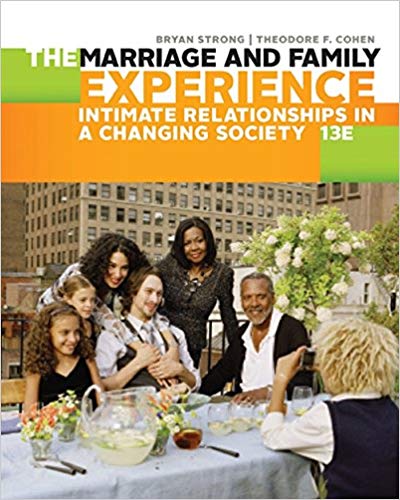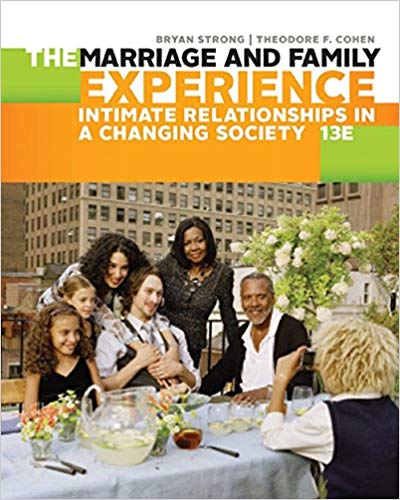This is completed downloadable of Test Bank for The Marriage and Family Experience 13th by Strong

Product Details:
- ISBN-10 : 1305503104
- ISBN-13 : 978-1305503106
- Author:
THE MARRIAGE & FAMILY EXPERIENCE offers a realistic look at relationships today, helping you see and understand the underlying issues at work in marriages, families, and all kinds of relationships. Real-life cross-cultural examples and features that encourage you to reflect on your own life and behavior make the thirteenth edition accessible and compelling. You’ll find up-to-date information on adoptive parenting, childbearing patterns, gay and lesbian families, the transgender experience, the meaning of virginity, gender roles, communication and conflict resolution, the influence of popular culture, and working families. With thorough coverage that reflects the diversity of families and relationships, the book illustrates how racial, cultural, economic and sexual differences shape relationships and families, and offers a straightforward overview of the topics you must understand to succeed in your course. This is a book you can relate to — and one you will want to read.
Table of Content:
- Chapter 1: The Meaning of Marriage and the Family
- Personal Experience, Social Controversy, and Wishful Thinking
- Experience versus Expertise
- Dramatic Changes, Increasing Diversity, and Continuing Controversy
- What Is Marriage? What Is Family?
- Defining Marriage
- Who May Marry?
- Exploring Diversity Ghost or Spirit Marriage
- Public Policies, Private Lives Obergefell v. Hodges
- Forms of Marriage
- Defining Family
- What Families Do: Functions of Marriages and Families
- Real Families The Care Families Give
- Why Live in Families?
- Extended Families and Kinship
- Kinship Systems
- Issues and Insights Cyber Caregiving and Technological Togetherness
- Multiple Viewpoints of Families
- Half Full versus Half Empty
- Conservative, Liberal and Centrist Perspectives
- Attitudes Toward Changes in Family Living: Accepters
- Issues and Insights Red and Blue Families
- Popular Culture Has There Been a “Modern Family Effect”?
- The Major Themes of This Text
- Families Are Dynamic
- Families Are Diverse
- Outside Influences on Family Experience
- The Interdependence of Families and the Wider Society
- Summary
- Chapter 2: Studying Marriages and Families
- How Do We Know about Families?
- How the Media Misrepresent Family Life
- (Un)reality Television
- Advice, Information, and Self-Help Genres
- Researching the Family
- The Importance of Objectivity
- Popular Culture Evaluating the Advice and Information Genre
- The Scientific Method
- Concepts, Variables, Hypotheses, and Theories
- Theoretical Perspectives on Families
- Macro-Level Theories
- Issues and Insights Conceptualizing the Effects of a Disaster
- Micro-Level Theories
- Applying Theories to Family Experiences
- Conducting Research on Families
- Ethics in Family Research
- Survey Research
- Clinical Research
- Observational Research
- Experimental Research
- Applied Family Research
- Exploring Diversity Researching Dating Violence Cross-Culturally
- How to Think about Research
- Summary
- Chapter 3: Variations in American Family Life
- American Families across Time
- The Colonial Era (1607–1776)
- Marriages and Families in the 19th Century
- Marriages and Families in the 20th Century
- Late Twentieth-Century Families
- Families Today
- Factors Promoting Change
- How Contemporary Families Differ from One Another
- Economic Variations in Family Life
- Issues and Insights Marrying across Class
- Class and Family Life
- The Dynamic Nature of Social Class
- Exploring Diversity Maintaining Strong Kin Ties: The Roles of Race and Class
- Real Families Middle-Class Parenting
- Racial and Ethnic Diversity
- Defining Race
- Racial and Ethnic Groups in the United_States
- Popular Culture Blackish
- Summary
- Chapter 4: Gender and Family
- What Gender Is, What Gender Isn’t
- What Gender Is
- Public Policies, Private Lies: What Should We Call Each Other?
- Popular Culture Television’s Transgender Faces
- What Gender Isn’t
- Gender Socialization
- Socialization through Social Learning Theory
- Exploring Diversity The Work Daughters Do to Help Families Survive
- Learning Gender Roles and Playing Gendered Roles
- Issues and Insights Gender and Bullying
- Continued Gender Development in Adulthood
- College
- Marriage
- Parenthood
- The Workplace
- Gendered Family Experiences
- Women’s and Men’s Roles in Families and Work
- Continued Constraints of Contemporary Gendered Roles
- Transgender Family Experience
- Gender Movements and the Family
- Real Families Making Gender Matter Less
- What about Men?
- Summary
- Chapter 5: Intimacy, Friendship, and Love
- The Need for Love and Intimacy
- The Intimacy of Friendship and Love
- Why It Matters: The Importance of Love
- Love and Families in the United States
- The Culture of Love
- Exploring Diversity Isn’t It Romantic? Cultural Constructions of Love
- Gender and Intimacy: Men and Women as Friends and Lovers
- Gender and Friendship
- Gender and Love
- Showing Love: Affection and Sexuality
- Exploring Diversity A Kiss Is Just a Kiss? It Depends
- Gender, Love and Sexual Activity
- Sexual Orientation and Love
- Love, Marriage, and Social Class
- What Is This “Crazy Little Thing Called Love”?
- Studying Love
- Love and Attachment
- Love and Commitment
- Finding Love and Choosing Partners
- The Relationship Marketplace
- Physical Attractiveness: The Halo Effect
- Going Out, Hanging Out, and Hooking Up
- Dating
- Problems in Dating
- Hooking Up
- Jealousy: The Green-Eyed Monster
- Breaking Up
- Popular Culture Chocolate Hearts: Chocolate Heears, Roses, and … Breaking Up? What about “Happy Va
- Lasting Relationships through the Passage of Time
- Summary
- Chapter 6: Understanding Sex and Sexualities
- Sexual Scripts
- Gender and Sexual Scripts
- Contemporary Sexual Scripts
- How Do We Learn about Sex?
- Parental Influence
- Siblings
- Peer Influence
- Media Influence
- Popular Culture Sex , Teens , and Television
- A Caution about Data on Sex
- Attitudes about Sex
- Sexuality in Adolescence and Young Adulthood
- Adolescent Sexual Behavior
- Public Policies , Private Lives “Sexting”
- Unwanted, Involuntary , and Forced Sex
- Virginity and Its Loss
- Gay , Lesbian , and Bisexual Identities
- Issues and Insights The Different Meanings of Virginity Loss
- Counting the Gay , Lesbian , and Bisexual Populations
- Identifying Oneself as Gay or Lesbian
- Sexual Frequency and Exclusivity
- Anti-LGBT Prejudice and Discrimination
- Bisexuality
- Exploring Diversity The Good , the Bad , and the Ugly: Trends in the Status of the LGBT Population i
- Sexuality in Adulthood
- Developmental Tasks in Middle Adulthood
- Sexuality and Middle Age
- Psychosexual Development in Later Adulthood
- Adult Sexual Behavior
- Autoeroticism
- Interpersonal Sexuality
- Oral–Genital Sex
- Sexual Expression and Relationships
- Nonmarital Sexuality
- Marital Sexuality
- Relationship Infidelity and Extramarital Sexuality
- Sexual Enhancement
- Sexual Problems and Dysfunctions
- Causes of Sexual Problems
- Psychological or Relationship Causes
- Resolving Sexual Problems
- Issues Resulting from Sexual Involvement
- Sexually Transmitted Infections
- Protecting Yourself and Others
- Sexual Responsibility
- Summary
- Chapter 7: Communication, Power, and Conflict
- Verbal and Nonverbal Communication
- The Functions of Nonverbal Communication
- Popular Culture Staying Connected with Technology
- Proximity, Eye Contact, and Touch
- Gender Differences in Communication
- Gender Differences in Partner Communication
- Communication Patterns in Marriage
- Premarital Communication Patterns and Marital Satisfaction
- Sexual Communication
- Demand–Withdraw Communication
- Communicating Too Much?
- Other Problems in Communication
- Topic-Related Difficulty
- Barriers to Effective Communication
- Positive Communication Strategies
- Power, Conflict, and Intimacy
- Power and Intimacy
- Sources of Marital Power
- Explanations of Marital Power
- Intimacy and Conflict
- Experiencing Conflict
- Dealing with Anger
- How Women and Men Handle Conflict
- Exploring Diversity Gender and Marital Conflict
- Conflict Resolution and Relationship Satisfaction
- Public Policies, Private Lives: “Can We Learn How to Manage and Avoid Conflict?”
- Common Conflict Areas: Sex , Money , and Housework
- When the Fighting Continues
- Consequences of Conflict
- Mental Health
- Physical Health
- Familial and Child Well-Being
- Can Conflict Be Beneficial?
- Resolving Conflicts
- Agreement as a Gift
- Bargaining
- Coexistence
- Forgiveness
- Helping Yourself by Getting Help
- Issues and Insights Should I Stay or Should I Go? Should We Try or Should We Stop?
- Summary
- Chapter 8: Marriages in Societal and Individual Perspective
- Marriage in American Society
- Behavior Trends
- Attitudes about Marriage
- The Economic and Demographic Aspects Discouraging Marriage
- What about Class?
- Does Not Marrying Suggest Rejection of Marriage?
- Somewhere between Decline and Resiliency
- Religion and Marriage
- Exploring Diversity Arranged Marriage
- Who Can We Marry?
- Marriage between Blood Relatives
- Age Restrictions
- Number of Spouses
- Marriage Equality: The Controversy over Same-Sex Marriage
- Who Do We Marry?: The Marriage Market
- Homogamy
- Black–White Intermarriage
- Religion
- Socioeconomic Status
- The Marriage Squeeze and Mating Gradient
- Marital and Family History
- Residential Propinquity
- Understanding Homogamy and Intermarriage
- Theories and Stages of Choosing a Spouse
- Public Policies, Private Lives ‘Will You Marry Us?”
- Why Marry?
- Benefits of Marriage
- Is It Marriage?
- Or Is It a Good Marriage?
- Predicting Marital Success
- Background Factors
- Personality Factors
- Relationship Factors
- Engagement, Cohabitation, and Weddings
- Engagement and Cohabitation
- Weddings
- In the Beginning: Early Marriage
- Establishing Marital Roles
- Establishing Boundaries
- Popular Culture Can We Learn Lessons about Marriage from Wife Swap and Trading Spouses?
- Social Context and Social Stress
- Marital Commitments
- How Parenthood Affects Marriage
- Middle-Aged Marriages
- Families as Launching Centers
- The Not-So-Empty Nest: Adult Children and Parents Together
- Reevaluation
- Aging and Later-Life Marriages
- Marriages among Older Couples
- Widowhood
- Enduring Marriages
- Summary
- Chapter 9: Unmarried Lives: Singlehood and Cohabitation
- Singlehood
- The Unmarried Population
- Popular Culture Celebrating and Studying Singlehood
- Never-Married Singles in the United States: An Increasing Minority
- Types of Never-Married Singles
- Singlism and Matrimania
- Cohabitation
- The Rise of Cohabitation
- Types of Cohabitation
- What Cohabitation Means to Cohabitors
- Cohabitation and Remarriage
- Cohabitation and Marriage Compared
- Effect of Cohabitation on Later Marriage
- Public Policies, Private Lives: Some Legal Advice for Cohabitors
- Issues and Insights Living Apart Together
- Common Law Marriages and Domestic Partnerships
- Real Families Heterosexual Domestic Partnerships
- Gay and Lesbian Cohabitation
- Same-Sex Couples: Choosing and Redesigning Families
- When Friends Are Like Family
- Real Families Elective Co-Parenting by Heterosexual and LGB Parents
- Summary
- Chapter 10: Becoming Parents and Experiencing Parenthood
- Fertility Patterns and Parenthood Options in the United States
- Unmarried Parenthood
- Forgoing Parenthood: “What If We Can’t?” “Maybe We Shouldn’t”
- Waiting a While: Parenthood Deferred
- How Expensive Are Children?
- Choosing When: Is There an Ideal Age at Which to Have a Child?
- Popular Culture: 16 and Pregnant, Teen mom, and the Reality of Teen Pregnancy and Motherhood with Br
- Pregnancy in the United States
- Being Pregnant
- Sexuality during Pregnancy
- Men and Pregnancy
- Experiencing Childbirth
- The Critique against the Medicalization of Childbirth
- The Feminist Approach
- What Mothers Say
- Giving Birth
- Real Families Men and Childbirth
- Infant Mortality
- Coping with Loss
- Choosing How: Adoptive Families
- Why People Adopt
- Characteristics of Adoptive Families
- Open Adoption
- Becoming a Parent
- Public Policies , Private Lives When Adoptions Dissolve
- Taking on Parental Roles and Responsibilities
- Parenthood and Traditionalization
- Parental Roles
- Motherhood
- Fatherhood
- What Parenthood Does to Parents
- Strategies and Styles of Child Rearing
- Contemporary Child-Rearing Strategies
- Styles of Child Rearing
- Public Policies , Private Lives To Spank or Not to Spank?
- What Do Children Need?
- What Do Parents Need?
- Diversity in Parent–Child Relationships
- Effects of Parents’ Marital Status
- Ethnicity and Parenting
- Gay and Lesbian Parents and Their Children
- Real Families Having a Gay Parent
- What about Nonparental Households?
- Parenting and Caregiving throughout Life
- Parenting Adult Children
- Grandparenting
- Children Caring for Parents
- Adults and Aging Parents
- Summary
- Chapter 11: Marriage, Work, and Economics
- Workplace and Family Linkages
- It’s about Time
- Time Strains
- Work and Family Spillover
- The Familial Division of Labor
- The Traditional Pattern
- Exploring Diversity Industrialization “Creates” the Traditional Family
- Men’s Traditional Family Work
- Women’s Traditional Family Work
- Women in the Labor Force
- Why Did Women’s Employment Increase?
- Attitudes of and about Employed Women
- Women’s Employment Patterns
- Dual-Earner and Dual-Career Families
- Typical Dual Earners
- Emotion Work
- Caring for Children
- How the Division of Household Labor Affects Couples
- Atypical Dual Earners: Shift Couples and Peer Marriages
- Shift Work and Family Life
- Peer and Postgender Marriages
- Coping in Dual-Earner Marriages
- At-Home Fathers and Breadwinning Mothers
- Family Issues in the Workplace
- Discrimination Against Women
- The Need for Adequate Child Care
- Older Children, School-Age Child Care, and Self-Care
- Inflexible Work Environments, Stressful Households, and the Time Bind
- Living without Work: Unemployment and Families
- Families in Distress
- Emotional Distress
- Real Families “Like an Unstoppable Illness . . .”
- Coping with Unemployment
- Reducing Work–Family Conflict
- Public Policies, Private Lives: The Family and Medical Leave Act
- Summary
- Chapter 12: Intimate Violence and Sexual Abuse
- Abuse, Intimate Partner Violence, and Family Violence: Definitions and Prevalence
- Types of Intimate Partner Violence
- Prevalence of Intimate Violence
- Issues and Insights Does Divorce Make You Safer?
- Why Families Are Violent: Models of Family Violence
- Individualistic Explanations
- Ecological Model
- Feminist Model
- Social Stress and Social Learning Models
- Exchange–Social Control Model
- The Importance of Gender, Power, Stress, and Intimacy
- Women and Men as Victims and Perpetrators
- Female Victims and Male Perpetrators
- Characteristics of Male Perpetrators
- Female Perpetrators and Male Victims
- Familial and Social Risk Factors
- Socioeconomic Class and Race
- Socioeconomic Class
- Race
- LGBT Experience of Intimate Violence
- Emotional and Psychological Abuse
- Spousal and Intimate Partner Sexual Violence
- Dating Violence and Date Rape
- Tweens, Teens, and Young Adults: Dating Violence and Abuse
- Issues and Insights “CALL ME!!! Where ARE U? ”
- Date Rape and Coercive Sex
- When and Why Some Women Stay in Violent Relationships
- The Costs and Consequences of Intimate Violence
- Children as Victims: Child Abuse and Neglect
- Prevalence of Child Maltreatment
- Families at Risk
- Hidden Victims of Family Violence: Siblings, Parents, and the Elderly
- Sibling Violence
- Public Policies, Private Lives: “Nixzmary’s Law,” “Elisa’s Law,” and “Erin’s Law”
- Parents as Victims
- Elder Abuse
- The Economic Costs of Family Violence
- Real Families Working the Front Line in the Fight against Child Abuse
- Responding to Intimate and Family Violence
- Intervention and Prevention
- Intimate Partner Violence and the Law
- Working with Offenders: Abuser Programs
- Confronting Child and Elder Abuse
- Child Sexual Abuse
- Children at Risk
- Forms of Intrafamilial Child Sexual Abuse
- Sibling Sexual Abuse
- Effects of Child Sexual Abuse
- Summary
- Chapter 13: Coming Apart: Separation and Divorce
- The Meaning of Divorce
- The Legal Meaning of Divorce
- The Multiple Realities of Divorce
- Divorce in the United States
- Measuring Divorce: How Do We Know How Much Divorce There Is?
- Divorce Trends in the United States
- Factors Affecting Divorce
- Societal Factors
- Demographic Factors
- Exploring Diversity Divorcing in Iran and India , but NOT the Philippines
- Life Course Factors
- Family Processes
- Issues and Insights Ending a “Not Quite Good Enough” Marriage
- No-Fault Divorce
- Uncoupling: The Process of Separation
- Initiators and Partners
- The New Self: Separation Distress and Postdivorce Identity
- Establishing a Postdivorce Identity
- Dating Again
- Popular Culture Making Personal Trouble Public: Sharing One’s Divorce Online or in Print
- Consequences of Divorce
- Economic Consequences of Divorce
- Noneconomic Consequences of Divorce
- Children and Divorce
- How Children Are Told
- The Three Stages of Divorce for Children
- Children’s Responses to Divorce
- Perspectives on the Long-Term Effects of Divorce on Children
- Just How Bad Are the Long-Term Consequences of Divorce?
- Issues and Insights What Would You Do?
- Child Custody
- Types of Custody
- Noncustodial Parents
- Divorce Mediation
- What to Do about Divorce
- Public Policies, Private Lives: Covenant Marriage as a Response to Divorce
- Summary
- Chapter 14: New Beginnings: Single-Parent Families, Remarriages, and Blended Families
- Single-Parent Families
- Characteristics of Single-Parent Families
- Children in Single-Parent Families
- Successful Single Parenting
- Binuclear Families
- Subsystems of the Binuclear Family
- Recoupling: Relationship Development in Repartnering
- Remarriage
- Rates and Patterns of Remarriage
- Characteristics of Remarriage
- Marital Satisfaction and Stability in Remarriage
- Remarried Families
- Real Families Are We Family? When Families Blend and Unblend
- A Different Kind of Family
- Issues and Insights Different Families , Different Obligations
- The Developmental Stages of Stepfamilies
- Stepparenting
- Problems of Women and Men in Stepfamilies
- Issues and Insights Claiming Them as Their Own: Stepfather–Stepchild Relationships
- Children in Stepfamilies
- Conflict in Stepfamilies
- Public Policies, Private Lives Inconsistent to Nonexistent: Lack of Legal Policies about Stepfamilie
- Strengths of Stepfamilies
- Summary
- Glossary
- Bibliography
- Index





